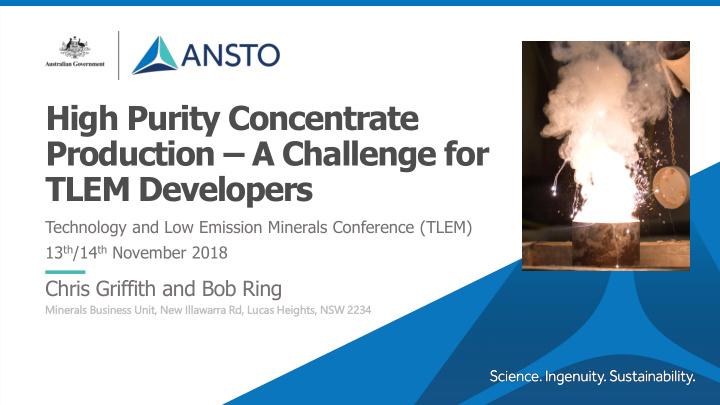



High Purity Concentrate Production – A Challenge for TLEM Developers Technology and Low Emission Minerals Conference (TLEM) 13 th /14 th November 2018 Chris Griffith and Bob Ring Miner nerals ls Busin usiness Un Unit it, , New ew Illa lawarra Rd, , Lu Lucas Hei eights ts, , NSW 22 2234
Context Mineral Mineral Intermediate Final Concentrate Concentrate Chemical Chemical (for refining) (final) Concentrate Concentrate Majority of projects focussed on ‘final, high purity products’
Three (3) Key Questions Question 1. “What is high purity?” Question 2. “How do different high purity concentrate specifications compare?” Question 3. “What’s the problem with analysing high purity concentrates?”
Question 1 “What is high purity?” > relative to context – mineral versus elemental e.g. 99% mineral purity vs 99% chemical compound Exclusively concerned with chemical purity, typically for a given chemical species e.g. Li 2 CO 3 , LiOH.H 2 O, NiSO 4 .6H 2 O etc In some case, at very high purities, only the specification for impurities might be provided
Question 2 “How do different high purity concentrate specifications compare?” The intention is to not focus in-depth on each specification, but to simply understand the variation and typical minimum / maximum values of impurities Includes lithium, uranium, rare earths, manganese, cobalt, nickel and silica/quartz (ANSTO exposure) Not intended as exhaustive listing. Obvious extension to HPA & V
Lithium FMC FMC Source CLPC BG1 Lithium EV Grade# Source Lithium Clariant SMM Spec. Type Low High V. Low Spec. Type Low High Alt. LiOH (min) % 56.5 56.5-58.5 56.5 99.5 99.5 99.6 Li2CO3 (min) % H2O* wt% Determined by weight loss H2O* wt% ns 0.5 0.1 Al ppm 10 Al ppm 5 10 5 Ca ppm 15 100 150 B ppm 5 Cd ppm 1 Ca ppm 60 400 20 Cr ppm 5 1 Cr ppm 1 Cu ppm 5 10 Cu ppm 5 5 1 Fe ppm 5 20 7 F ppm 50 Hg ppm 1 Fe ppm 10 5 5 K ppm 10 50 200 K ppm 10 5 Mg ppm 50 Li 2 CO 3 Footnotes Mg ppm 10 10 Na ppm 20 100 80 CLPC - China Lithium Products Tech. Mn ppm 5 1 BG - Battery Grade Ni ppm 10 * at 500C / 30 min. Na ppm 20 500 10 Pb ppm 10 1 # undisclosed source Ni ppm 6 5 Si ppm 30 200 ns - not specified Pb ppm 20 1 ppm quoted at maximum value Zn ppm 10 70 5 Si ppm 40 Cl ppm 20 50 50 LiOH Footnotes Zn ppm 5 S ppm 33 100 SMM - Shanghai Metals Market Cl ppm 35 100 10 * at 500C / 30 min. SO4 ppm 100 300 150 ns - not specified S ppm 10 334 50 Sn ppm 1 ppm quoted at maximum value SO4 ppm 30 1,000 150 CO2 wt% 0.3 0.5 0.5 Acid insolubles wt% 0.02 Acid insolubles wt% 0.01 d50 µm 2-8 6 d100 µm ns d90 µm 11 d100 µm 10
Specification Snapshot 1x10 -5 for 238 U/ 232 Th + daughters!!!
Analysis Dection Element Technique Units Limit (DL) Comment Al,As,B,Be,Ca,Fe,K,Li,Mg,Na,P,S, ICP-OES ppm 2.5 Digest and analysis at minimum dilution Si ICP-OES ppm 2.5-12.5 Digest and analysis at minimum dilution Cd,Co,Cr,Cs,Cu, Mn,Mo,Ni,Pb,Rb,Sn,Th,Ti,U,Zn,Zr ICP-MS ppm 0.25-1.0 Digest and analysis at minimum dilution Cl,F ISE ppm 2.5-12.5 Digest and analysis at minimum dilution CO2/Ctotal LECO ppm 100 Direct measurement Mass Loss TGA ppm 20 Based on % of 25 mg Refers to ‘routine’ analysis methods Alternative method development possible – MS vs OES Total Dissolved Solids (TDS) plays a key role But if target (ppm) approaches the DL (ppm)….
Analysis – The Challenge Uncertainty defines that analysis ‘at or near’ the DL means is prone to error even in the absence of matrix effects, interferences etc
Analysis – The Challenge Tabulated data presentation Comparison of effect of reduced detection limit (at 12.5 ppm) Requires a change to mindset – analysis, interpretation and expectation At low levels, conventional analysis methods are likely to be inappropriate Calculated Solid Analysis (ppm) Calculated Solid Analysis (ppm) Measured Assumed Assumed Measured Error Ideal High Low (ICP-MS) Error Ideal High Low (ICP-OES) (mg/L) (%) (ppm) (mg/L) (%) (ppm) 5 5 125 131 119 50 5 1250 1313 1188 2.5 5 63 66 59 25 5 625 656 594 1 5 25 26 24 10 5 250 263 238 0.5 5 12.5 13 12 5 5 125 131 119 0.25 5 6.3 6.6 5.9 2.5 5 62.5 66 59 0.1 10 2.5 2.8 2.3 1 10 25 28 23 0.05 25 1.25 1.6 0.9 0.5 25 12.5 16 9 0.025 50 0.625 0.9 0.3 0.25 50 6.25 9 3 0.01 100 0.25 0.5 0.0 0.1 100 2.5 5 0
Take Home Messages
Take Home Messages “ D on’t look, and you are guaranteed to not find anything wrong.” “To combat the issue, the company will build a US$25 million ion exchange system to remove the uranium, with commissioning expected by the end of June 2019 quarter, subject to approvals .”
Take Home Messages Specifications varying depending on the intended application and purpose – little value in comparing ‘apples with oranges’ Any specification dealing with >99.5% purity is going to ‘tight’ on a number or for most elements ALL projects which target such products will be challenged A change to mindset is required w.r.t. analysis, interpretation and expectation involving project development teams, service providers and vendors alike
Thank you
Recommend
More recommend